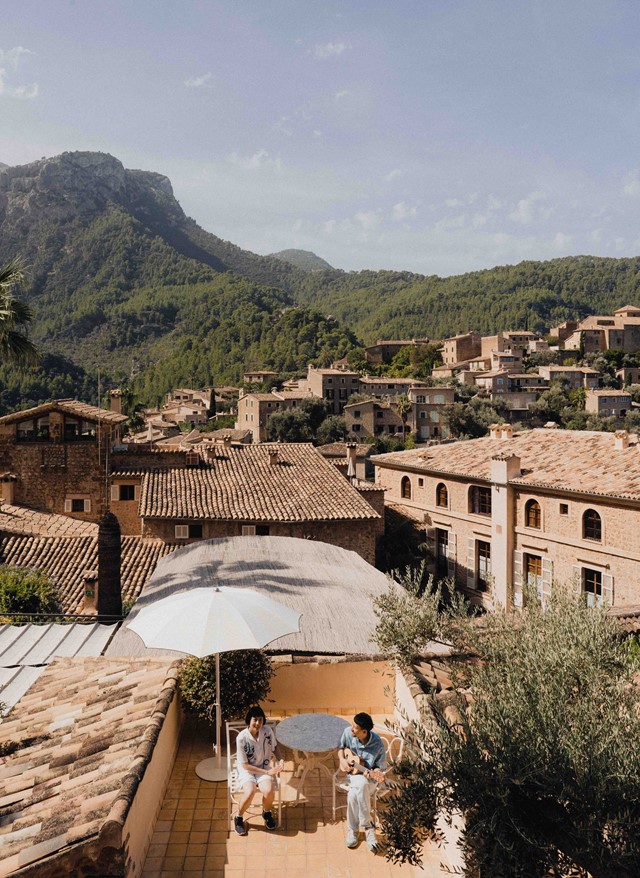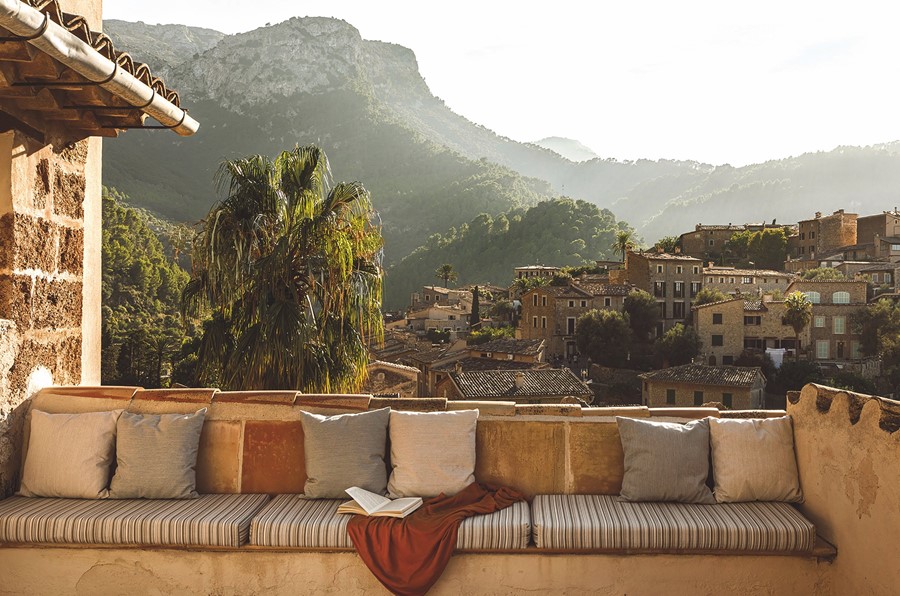Launched this autumn, a new residency at La Residencia in Deià is an idyllic artist’s residency in a bohemian oasis
Awoken by the clichéd sound of a cock’s crow, I step out onto the balcony and watch as the sun rises. The light casts an orange glow along Mallorca’s backbone, the peaceful Tramuntana mountains. Deià, a small coastal enclave encircled by these peaks, consists of clear waters, cliffside views, stone houses, and winding roads through a thick forest. The region’s dreamlike quality charms celebrities, who dine at local restaurants and dance at tiny local bars like Sa Fonda – or the easy-to-translate El Bar. One night I glanced across a room to see Emily Ratajkowski, Ziwe, and Moses Sumney breaking bread, on the way home after digesting fresh seafood at Ca’s Patró March. I recognise Andrew Lloyd Webber waiting for transport up the giant incline ahead and, for some reason, I tell him that “I love Cats”. He owns a house nearby and has written several of his Broadway hits within the village’s dramatic landscape that fittingly resembles an amphitheatre. This is ostensibly a village for artists in search of inspiration, desperate to recalibrate, and has been since Robert Graves – the 19th-century poet – settled there and wrote of its beauty.
“It’s just breathtaking,” photographer Pixy Liao tells me of her new setting. “I can’t believe this is real.” She’s one of three artists who applied to live in this oasis and create for free for two months as part of a new residency at La Residencia that launched this autumn. Liao, 44, hails from China but lives in New York with her younger Japanese partner Moro, 39. Together the pair feature in her challenging photography which subverts what is expected of heterosexual relationships and of Asian women who are often fetishised and characterised as submissive, and the tensions between their two home countries through a series of absurd selfies. In her series Your Gaze Belongs to Me, seen on Dazed, one image sees her bend her partner over her knee while she prepares to whip his bare bottom. “My secret is not to tell him too much before the photoshoot.”

While her stint finished in October, Anastasiia Podervianska, a Ukrainian textile artist, who often makes work about death, preceded her and enjoyed a peaceful retreat. As did Sislej Xhafa, an Albanian painter, performance artist and craftsman from Kosovo who is no stranger to subverting his surroundings. The 53-year-old artist once created a living sculpture by transforming a Ghent police station waiting room into a grand palace with luxurious interiors, a comment on how some institutions’ hostility to communities, to beauty, is by design.
“Most of my photos are not taken in my home where we’ve lived for ten years. It’s not photographical, there’s not much light,” she says. The limits of not having a big room and never having had a studio have melted away as the residency includes access to a private studio and the pair can go “out of [their] comfort zone” by including the natural landscape and shooting outside. Getting three meals a day and accommodation covered means she feels like there’s more “possibilities” to make work she never usually has time to make.
The surrounding village’s shift from the authentic artists’ “colony” it once was to a playground for the super-rich has sometimes been blamed on luxury dwellings like La Residencia, where rooms can start at 700 euros per night. I ask a very friendly and very drunk local real estate agent in El Bar what the cheapest house I could purchase would set me back and she tells me nothing exists for under a million. “Deià became famous for what the Spanish call ‘tertulias’, gatherings of writers, and intellectuals. It was all word of mouth before WhatsApp or emails. Then the place kind of became hip,” says Hanna Bornebusch, as we tour the grounds of La Residencia.

The hotel has developed a reputation as one of the most prestigious stays in the area, owing to its unique interiors where each room is filled with lovingly hand-picked antiques and art. Along with its gallery exhibitions, walking tours to local studios and on-site sculptures, its recent artist’s residency is one way it’s trying to keep up Deià’s tradition of being a creative studio for anyone wanting to sharpen their craft, housing them in five-star dwellings and feeding them at restaurants other tourists wait months for a booking, like El Olivo, which recently went viral on Tik Tok and Instagram. Items on the menu pay homage to local artists. For example, the on-site restaurant Miro has a dish that honours artwork of the late Georges Sheridan that depicts Cala Deià, a nearby idyllic beach using ingredients like pine nuts to evoke his painting of the pine trees and fish.
Does allowing artists free reign over the space impact the great shift that’s happening in the village between the free-spirited bohemians and multi-millionaires? “For me, art is the only democracy that exists,” says Sislej Xhafa. “It’s important to have a sacred place or a monastery where we practice our freedom.” During his stay, he created Blue Blossom, an ATM machine tied to the top of a tall tree that he has crafted to be a home and feeder for local birds. By showing a “mutation” of two worlds working together in the piece, it evokes the duality of Deià and the essence of the artist residency itself. “ATMs are a very important symbol of exchange,” he adds. “Here, we’re experiencing cultural and emotional exchange.”
La Residencia will be accepting applications for the next artist residency in February and is reopening for visitors in March.
